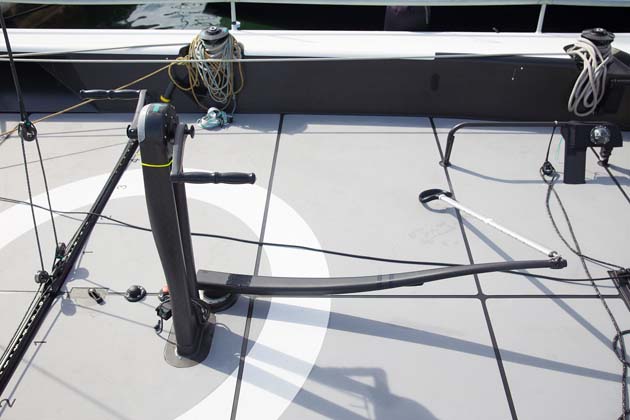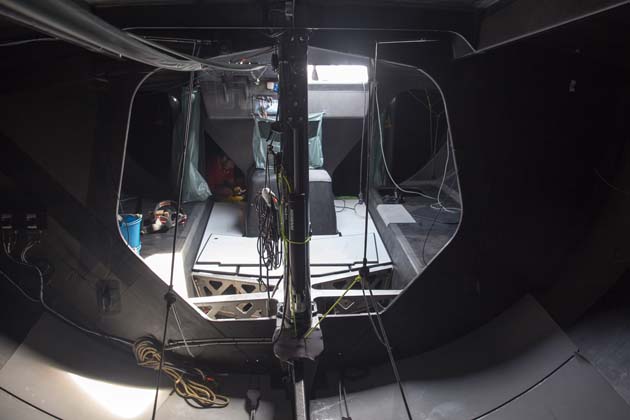The new TP52s have better performance, but it is up to crews to tweak rig and sails. And none do it better than this Botin &n Partners design, says James Boyd
Celebrating its tenth anniversary in Europe this year, racing’s premier keelboat class, the TP52, is in surprisingly good health. Through careful management it has avoided the dramatic cost escalation that typically destroys ‘box rule’ classes and, three years ago, it survived the demise of its circuit, the Audi MedCup.
That the 52 circuit exists today is thanks to its salvage by three owners – Rán’s Niklas Zennström, Quantum Racing’s Doug de Vos and Matador/Azzurra’s Alberto Roemmers – the stakeholders in the 52 Super Series. Far from dying, the TP52 is again on the ascent. On the startline this season will be nine brand new boats, all built to the latest ‘turboed’ version of the TP52 rule.
In the past an embarrassment for the 52s was that whenever they were taken out of class to race, for example, under IRC, they ended up faster with deeper bulbs, more sail, composite rigging, etc. This is now no longer the case, thanks to sweeping rule changes.
These include increasing draught 150mm to 3.5m, reducing overall displacement (to 7,025kg), increasing sail area (eg main up to 98m2 from 93.5m2) and using higher modulus carbon fibre in mast, boom and bowsprit.
Nine new boats is great news for the class, but it’s disappointing that they’ve emerged from only two designers. The two TP52 heavyweights, Quantum Racing and Azzurra, plus new 52 teams Alegre and Bronenosec, are all from Botin & Partners, built in Spain, while Rán, Gladiator, Provezza, Platoon and Sled are Judel-Vrolijk, built as far afield as New Zealand and the UAE.
Identical hulls
Quantum Racing, Alegre/Azzurra and Bronenosec all have identical hulls. The reason, says Botin & Partners’ Adolfo Carrau, is because their TP52s no longer target a specific wind range. Instead they are so adaptable that, with some rejigging of their set-up, they are competitive across a wide range of conditions.
The teams also prefer this, says Carrau: “If one has a ‘light air’ boat and another has one for ‘moderate’ airs then it just leads to frustration, because everyone knows the first will do better in sub-ten knots and the second will do better over ten. This leaves the crews to tweak the appendages, sails and rig . . .”
Botin & Partners is the most successful design house in TP52s, having penned the 52 Super Series/Audi MedCup winner every year since 2008. Of these, Quantum Racing has been the most successful, winning in 2008, 2011, 2013 and 2014.
The most outstanding feature of the new Quantum Racing, the third Botin & Partners design for Doug de Vos’s team, is the swirly ‘time tunnel’ paintjob on the sails. This certainly makes the boat stand out and, of course, key to the campaign is not only to showcase Quantum sails, but to carry out R&D into sail shapes to validate the company’s iQ Technology software. Among the avenues under investigation are mainsails with shorter foot lengths.
The new-generation Botin 52s have softer turns rather than chines and redistributed volume to help offset the increased power of the rig. According to Carrau, the designers have attempted to improve downwind performance, an area where gains can particularly be made – as boats get lighter, they become more inclined to plane.
Significant work by Pure Engineering has gone into the structure, where the aim is to concentrate weight in the centre of the boat and lower the vertical centre of gravity.
Increase in performance
Carrau says the new TP52s have a three or four per cent increase in performance across the board, causing the TP52 to take another step away from being a ‘small big boat’ towards being a large sportsboat.
In addition, lowering the mast’s centre of gravity and fitting composite standing rigging – typically Southern Spars carbon fibre EC6 – has reduced pitching, improving performance upwind and in waves. “I think they are as up-to-date as they can be now. They have caught up and even exceeded the speed of the IRC 52s, which is good.”
Where TP52s are especially interesting is in the incredible lengths to which teams go to ensure not only that they sail to maximum efficiency both upwind and down in terms of cockpit layout and crew positioning, but can also turn corners and carry out manoeuvres in the most efficient way with the minimum of foul-ups. Modern TP52s represent the last word in ‘tweaky’.
And nowhere is this more evident than with Quantum Racing. From within its two 40ft containers – one a fully-speced workshop, the other a sail loft – the American team conjures up custom-built widgets in its quest for ultimate refinement.

With the companionway offset to port, the minimalist pit is to starboard and is recessed to minimise windage
Focusing on the sides of the cockpit, you can see a multitude of tiny control lines. Standard fit on TP52s, for example – to the extent that it features in the class rule – is a line that when pulled causes a small pole to extend out from the end of the bowsprit. This prevents sheets from dropping over the end of the bowsprit during gybes.
Over the years windage has become a big concern. The mast area has always been slippery, with the gooseneck covered by a neoprene sleeve, as is the mast where it penetrates the deck. On their previous 52, Quantum Racing pioneered mounting jib tracks below deck, leaving just a ring protruding through a narrow slot, while the carbon fibre pulpit is about as minimal as it can be with the lashings for the Dyneema upper guardrail running through the pulpit and terminating below deck.
The pit area has become reasonably standardised, sunken below deck height and with just a single winch – this is no longer driven by the pedestals, as halyards are instead fed to the spare primary.
Cockpit layout
The biggest differences boat to boat remain in the cockpit. Although all the boats have tiller steering and have their aft pedestal mounted immediately adjacent to the rudder stock, winch positions differ. Of the two circuit heavyweights, Quantum Racing has them further inboard and recessed, whereas Azzurra has them mounted on deck and further outboard, with bigger runner winches to crank up runner/forestay tension for the ultimate in flexible trim.

The after of the two grinders is mounted beside the rudder stock to keep weight aft when sailing downwind
Quantum Racing makes a considerable amount of custom gear in-house and this includes its own carbon fibre headsail furling drums and the reel system for spinnaker sheets. If you’re unfamiliar with the latter, they cause spinnaker sheet ends to be sucked up rapidly onto a spool below deck, keeping the cockpit free of excess rope. Although companies such as Diverse Yacht Systems make this rarefied gear, Quantum Racing has conjured up its own.
The team has also made progress with its spinnaker take-down system, a line attached to the centre of the spinnaker that ultimately ends up on a primary winch, enabling the kite to be sucked down below the foredeck hatch in just three or four seconds.
Whereas most take-down systems require a substantial roller below decks on the after side of the hatch, Quantum Racing has dispensed with this, relying on a curved underside to the hatch instead.
How much of this makes a difference on the racecourse is, of course, hard to quantify, but on a circuit today that is so competitive every little helps. Furthermore, what the big boys develop often has a way of filtering down to smaller boats.
Jib sheet tracks are hidden below deck. The vang this year is rope inside a carbon tube that can support the boom
Windage around the gooseneck is minimised with a neoprene sleeve
Down below looking aft, showing, on the front of the mast, the hydraulic ram for the deflectors and the metal frame supporting the keel. The lines running down from the deck either side are the enormous 45:1 purchases for the jib up-down
Specifications
LOA 15.85m/52ft 0in
Beam 4.42m/14ft 6in
Draught 3.50m/11ft 6in
Displacement 7,000kg/15,432lb
Mast height above DWL 23.80m/78ft 0in
Sail area:
Mainsail 98.0m2/1,055ft2
Jib 66.0m2/710ft2
Spinnaker 270.0m2/2,906ft2
Designer: Botin & Partners
Builder: Longitud Cero Composites, Spain
This is an extract from a feature in the July 2015 issue of Yachting World








